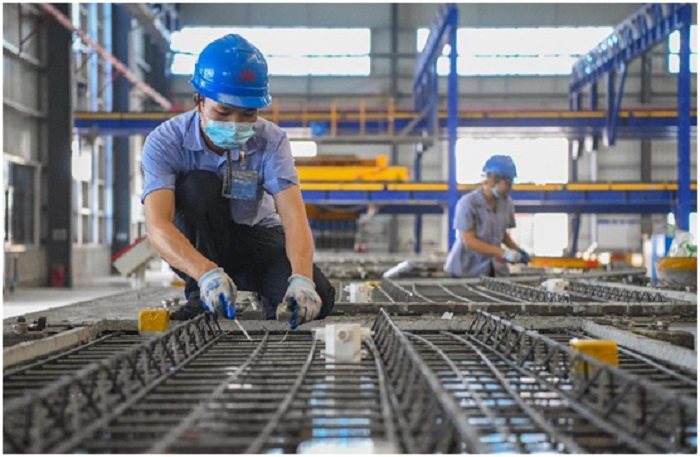



With 410 steel structural components, 197 roof plates, and 170 modules of photovoltaic curtain wall, workers finished assembling walls at the building-integrated photovoltaics center of China Energy Investment Group Co., Ltd., which covers an area of 1,063 square meters, in Changping district, Beijing, within seven days like putting together building blocks.
The above-mentioned construction process is a typical scenario of prefabricated construction, a new construction method featuring standardized design, factory production, building components assembly, integrated decoration, and information technology-based management.
The construction method delivers energy-saving and environmentally friendly construction products and maximizes the value of these products throughout their life cycles, thus realizing their sustainable development.
In recent years, prefabricated construction has developed rapidly in China. Data showed that in 2020, prefabricated construction projects covering a total area of 630 million square meters kicked off on the Chinese mainland, up 50 percent from that in 2019, which accounted for 20.5 percent of the total area of new construction projects on the Chinese mainland in that year.
By the year 2025, prefabricated buildings will account for more than 30 percent of new construction projects in China, and the amount of construction waste at new construction sites will be less than 300 tons per 10,000 square meters, according to a newly released development plan for China’s construction industry over the country’s 14th Five-Year Plan period (2021-2025).
A market mechanism on construction waste treatment and recycling will be preliminarily established and a batch of green construction demonstration projects will be launched by 2025, said the plan released by the Ministry of Housing and Urban-Rural Development.
Compared with traditional construction methods, prefabricated construction, in which building components are often prefabricated in factories and then assembled on construction sites, is not only more efficient, but also produces less construction waste and environmental pollutants, such as dust and noise.
“In a 30-storey residential building project with 35 percent of the building components being prefabricated, for instance, a building with precast concrete structure can save as much as 45 percent of the construction time, reduce energy consumption by up to 40 percent, and cut the number of construction personnel on site and the amount of construction dust by as much as 75 percent and 30 percent, respectively,” said Guan Yuancheng, an executive of the prefabricated construction industrial base of a company in south China’s Hainan province.
As one of the pillar sectors of the Chinese economy, the construction industry has achieved notable results in reform and development in recent years.
During the country’s 13th Five-Year Plan period (2016-2020), the value added of the construction industry grew by 5.1 percent on average on a yearly basis. In 2020, the total output value of the industry reached 26.39 trillion yuan (about $4.15 trillion) and the value added of the industry hit 7.2 trillion yuan. In the same year, the industry contributed 7.1 percent to China’s gross domestic product (GDP) and completed housing construction projects with a total construction area of 14.95 billion square meters, and 53.66 million people worked in the industry.
Nevertheless, the industry has been plagued by low development quality and efficiency issues, which vary from inefficient growth, low labor productivity to high energy consumption and emissions as well as market irregularities.
To further accelerate the transformation and development of the construction industry, the newly released development plan put forward major tasks for the industry, including speeding up the coordinated development of smart construction and industrialization of the construction of new-type buildings, improving market operational mechanism, improving construction and organization models of projects, cultivating workforce, perfecting project quality and safety assurance system, steadily improving projects’ earthquake resistance and disaster prevention capacity, as well as expanding into overseas markets at a faster pace.
The country will vigorously promote prefabricated construction, actively advance the construction of high-quality residential buildings with steel structure, and encourage schools, hospitals and other public buildings to give priority to steel structure, according to the plan.
The document also said that the country will build a batch of production bases for prefabricated construction, and facilitate cooperation among construction companies, Internet enterprises, scientific research institutions as well as other organizations, in a bid to enhance the integration of new-generation information technologies including the Internet of Things, big data, cloud computing, artificial intelligence, and blockchain into the construction industry.
A preliminary framework for high-quality development of the construction industry will take shape in China by 2025, when the industry will harvest important fruits in promoting industrialization, digitalization, intelligentization and green transformation, said the plan.


The Executive and members of the.


The Acting Director, FCT Directorate of.


President Bola Ahmed Tinubu has been.



Barely a month after resignation of.


An Abuja based Legal Practitioner, Osuagwu.



Convener of Equitable Remedy, Mrs. Magaret.


Contractors handling the contract for city.


Nigerian government may have concluded plans.


The Diplomatic Correspondents Association of Nigeria.


A rights group, “Follow Me Talk.
Leave a Comment